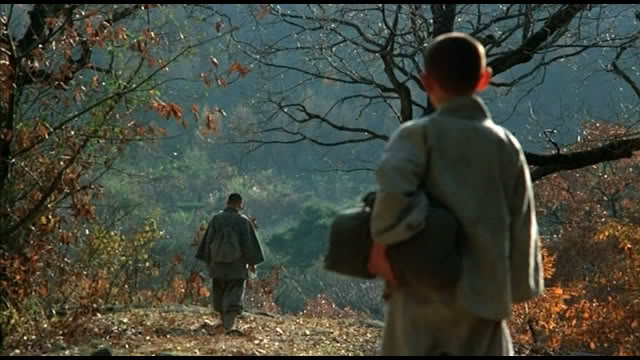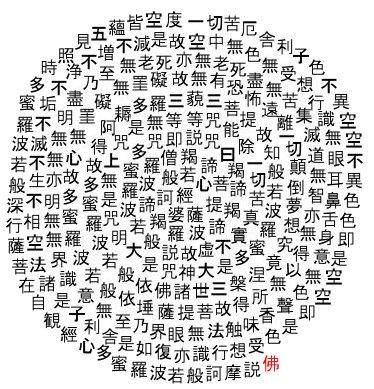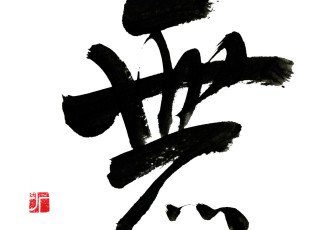Why Has Bodhi-Dharma Left for the East? is an award-winning South Korean film written, produced and directed by Bae Yong-kyun, a professor at Dongguk University in Seoul. Known principally as a painter, Bae spent seven years making this film with one camera and editing it by hand. The film was screened in the Un Certain Regard section at the 1989 Cannes Film Festival. The making of the film is a story in itself. The entire process of filming, production, and editing was done solely by Yong-kyun Bae and the film’s three actors were all amateurs.
The title of the film is a Zen koan— a riddle, a paradox meant to aid meditation—that provokes the question of the distinction between leaving and arriving. Why Has Bodhi-Dharma Left for the East? does not seek to explain the tenets of Zen Buddhism so much as illuminate the mysteries of life that lie behind them.
The movie revolves around the lives of three residents of a Buddhist temple, a Zen monastery on Mount Chonan in South Korea: the elderly abbot – who is approaching death, his disciple – who is troubled by the fact that he left his blind mother behind in order to seek enlightenment, and a young orphan, who enjoys wandering around in the woods learning about the transient nature of life. The movie portrays the characters as they directly confront the existential issues of loss, death, and suffering. In this remote mountain monastery above a bustling city, they live a life of quiet contemplation. The old master, nearing his end, wishes to make the ceremony of his death his final lesson to his apprentice. Meanwhile, the orphan has his own awakening to suffering and mortality.
The film’s minimal plot tells the story of the three ages of man. In fact, the three characters in the movie represent three different generations, each with their own ideal peculiarity: the curiosity of the childhood, that becomes the thirst for knowledge in the grown-up and acquired wisdom in old age.
At the end of the movie all the struggles resolve into peace. The old Master leaves his body, that is turned into ashes because a Zen master doesn’t want to leave any trace of his physical existence; the bird captured by the orphan kid is free, and the disciple looks out upon the mountains as he did at the beginning of the film, but now we see his eyes as well, presumably awakened to the reality of things, while the mountains again are mountains as before.
The film is one of the most beautiful ever made, but its beauty lies in the unforced simplicity of the imagery. The film is centered around Zen Buddhism yet it holds a universal relationship to us all in the reflection of samsara, of existence, of life and death. The film”s great achievement is that it does not reflect this with any messages but rather it simply is such, more than it is about such.
This movie has the power to show us with utter simplicity the very heart of simplicity. Much of the way the story develops depends upon the images of mountains, rivers, forests, fires, and faces. This magnificent film, quietly powerful and astonishingly rich in formal beauty, is not only a cinematic gem, with haunting visual allegories, and mystical imagery but an evocative meditation on the cyclical nature of existence. It is widely regarded as one of the most visually stunning films ever made.
Beautifully filmed in the remote Korean countryside, the movie involves minimal dialogue and occasional use of footage taken from real life. Some of the episodes in the film involve rich cultural metaphors, such as the young orphan’s search for a lost ox (in Zen temple art, the ox represents a human being’s true nature).
***
When the question Why has Bodhi-dharma left for the East? was put to the famous mystic Chao-Chou, he answered: «The cypress tree is in the courtyard». For the question doesn’t necessitate a mental answer but stimulate to ponder about the real essence of Buddhism, that is — in brief — the necessity of an inner awakening. To became enlightened means to awakens to all existences: stones, rivers, trees, animals, rain, fire. It means to start to see things as they really are. An old zen saying advices us: “Before practicing Zen, rivers were rivers and mountains were mountains. When I practiced Zen, I saw that rivers were no longer rivers and mountains no longer mountains. And now I see that rivers are again rivers and mountains are again mountains”.
Back in the fifth century, an Indian monk named Bodhidharma crossed the border into China to spread the word of Zen Buddhism. His new religion would soon become a hit throughout Asia before working its way to the West. Bodhidharma is considered the 28th Patriarch after Shakyamuni Buddha, and his departure from India to China, in 526 B.C., signs the beginning of Chan Buddhism.
Why has Bodhidharma left for the East? is the first Korean feature to ever have theatrical distribution in the United States.
photo credit: topentity




